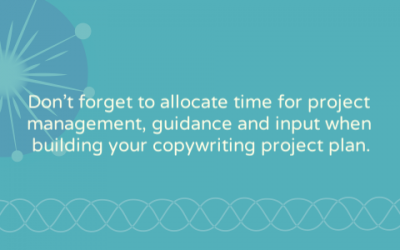 Although it’s my specialty, copywriting is rarely something that just happens magically for me. Even a professional copywriter has to grapple with that annoying interval between an idea or assignment, and the words flowing into a document.
Although it’s my specialty, copywriting is rarely something that just happens magically for me. Even a professional copywriter has to grapple with that annoying interval between an idea or assignment, and the words flowing into a document.
Though it can happen, I rarely just sit down and write. In fact, I have a bit of a process and routine I go through in order to distill the ideas and information I have on hand, get into the mindset for writing and actually start producing content:
Setting a timer
What: I strongly believe in setting a timer for 50 minutes during which I focus exclusively on the task at hand. During this time, I shut out any distractions (ignore all emails, phone calls, social media, tangential internet searches and even mind wandering), and make a commitment to 50 minutes of focused, uninterrupted productivity.
Why: I’ve learned that this self-imposed discipline allows me to produce an incredible amount of content. If I can fit in two or three of these 50-minute segments per day, I know I will accomplish a great deal and can put structure around when I tackle my other tasks and social media time.
Coffee
What: I get myself a coffee or other drink (and perhaps a snack) before I start a segment.
Why: Getting my coffee is part of settling in and getting as comfortable as possible – and removing any excuses for interruptions! It has become a bit of a ritual for me, so the coffee in hand really sets the tone.
Reading/reviewing background information
What: Highlighter, pen and notebook in hand, I pore over all of the available background information on paper, highlighting and making notes.
Why: This is part of immersing myself in the topic, especially if it’s new to me. I look for interesting or key points that I know will inspire me or be included in the final copy. The background information might include old marketing materials, the results of any research and phone interviews I’ve conducted, and any other relevant information (reports, memos, project brief).
Writing to distill
What: With pen and paper, I start writing: notes, brainstorming lists, mind maps, and content outlines. This isn’t the actual copywriting, it’s the content, including key messages and creative approach, beginning to take shape on paper and in my mind. This step builds upon the notes and ideas jotted down while reviewing the background information. I have a notebook dedicated to this task alone since scrap paper just won’t be organized enough in case I want to refer back.
Why: This is a warm up to writing; it transitions me from the process of absorbing information to the process of creating content. I find that the act of actually writing and forming letters instead of typing gets the creative juices flowing. These exercises help me to develop ideas, themes and structures. Mind maps help me to distill everything I’ve been thinking about so far and serve as a starting point for outlines.
Writing the draft copy
What: Time to move over to the computer and start writing in earnest.
Why: This step is obvious! With all of the steps I’ve taken so far, I feel fully immersed in the topic and ideas for how it should take shape have started to form. I have no excuse (and probably a fair bit of time left on the timer) but to start writing. And from here on in, I just write continuously until the timer goes off. If the timer sounds and I’m ready for a break, I take it and resume the work in my next 50-minute segment. If I’m still feeling energetic and inspired, I just keep going until I feel it’s the right time to stop.
Review background and all notes
What: With a rough draft in hand, I’ll go back over every single page of background information and all of my own notes to ensure that I’ve included all of the important information, ideas and key points.
Why: This step ensures that everything important is included. If there’s anything I’ve missed, I add it in here: all of it. It’s not editing time yet, it’s still creating time.
Walk away
What: Step away from the copy and take a break! This is when you get to check in on those e-mails, social sites, return phone calls or maybe even actually walk away and take a break from your desk.
Why: As I’ve described before, I always leave myself enough time to walk away from my copy. It’s important to take a break to come back with a fresh set of eyes – and to allow the opportunity for new ideas and new ways of approaching the content to arise.
Review the draft
What: It’s time to get into an editing frame of mind: rearranging, editing, proofreading, etc.
Why: Up until this point, I’ve focused only on creating. NOW I take a critical look at what I’ve produced; proofreading, improving and cutting the fluff. This is the most fun and easy part of copywriting for me. The hard work is done; this is about fine-tuning!
Ask someone else to review
What: Have someone else look at your writing. This might happen naturally as part of your structure/approval process.
Why: Years ago, a copywriter I know used to insist that the more you have worked with your copy, the less likely you are to see errors, and it really is true. Another reviewer can also share insights on the clarity and quality of your writing in general.
Depending on the size, scope and topic at hand, I may not use all of these steps. For large projects or work for a new client, they are all essential. For a simple blog post that’s been percolating in my mind for a while, I might skip several.
What is your copywriting process? How do you get into the mindset for creating content? Do you have habits, routines or rituals that help you with your copywriting?

![Internal copy review pet peeves – and help with getting useful feedback [includes swipe copy]](https://moflow.ca/wp-content/uploads/2021/02/sharable-boxes-3-400x250.png)

